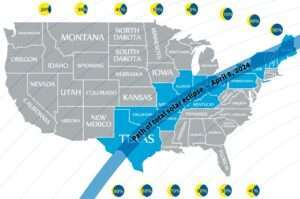By Cara Birrittieri
Author, Freelance Writer,
Science Teacher,
Maple Grove Substitute, CHQ County Resident
When was the last time you saw a total solar eclipse of the sun? The last time a solar eclipse hit America was 2017, but previous to that was 1979. I seem to recall that one when I was a teenager in Boston. All Chautauqua County residents are in for a real treat this coming Monday, April 8 when the path of totality will cross right over us. However, we are not alone. The Sun will cast a dark shadow all across North America.
According to NASA, the total solar eclipse will begin over the South Pacific Ocean. The first location in continental North America that will experience totality is Mexico’s Pacific coast at around 11:07am. The eclipse continues from Mexico, entering the United States in Texas, and traveling through Oklahoma, Arkansas, Illinois, Kentucky, Ohio, Pennsylvania, New York, Vermont, New Hampshire, and Maine. The eclipse will enter Canada in Southern Ontario, and continue through Quebec, New Brunswick, and Prince Edward Island. The eclipse will exit North America on the coast of Newfoundland, Canada, at 5:16pm NDT.
What does that all mean and why is it such a rare event?

Brewery, are having an Eclipse Fest on April 8 from 11am-7pm.
A solar eclipse happens when the Moon passes directly in front of the Sun’s light and casts its shadow on Earth. Therefore, during the day, the moon slowly moves over the sun and here on earth, where the moon’s shadow falls, it gets dark in the middle of the day.
On average a total eclipse of the sun actually happens once somewhere on earth about every year and a half. Note: a partial solar eclipse happens when the Moon only covers part of the sun; this happens at least twice a year somewhere on Earth.
These events are rare because we hardly ever get the chance to see a total solar eclipse where we live. The moon’s shadow is not very wide, and it crosses the earth in different places every time. Also, you have to be on the daylight side of the planet and in the direct path of the moon’s shadow.
NASA says, “On average, the same spot on Earth only gets to see a solar eclipse for a few minutes about every 375 years!”
Now that you understand how a solar eclipse works; you will grasp why a lunar eclipse is much more common. First, it’s important to know that the brightness of the moon is from the sun shining on its surface. That’s why we see the moon as a bright disc. When the earth blocks the sunshine on the moon’s surface it turns reddish and almost 3-demensional, like the ball that it is. Of course, the huge planet earth gets in the way of the sunshine on the moon more often because of its size. Also, more people can see a lunar eclipse because anyone on the side of the earth where the moon is, will see the eerie moon lacking sunshine.
All rare celestial events though the centuries were thought of as sinister, a doomsday omen. People associated solar eclipses with gods, demons, and even animals: in Asia it was a dragon; in Peru it was a puma; some Native Americans imagined a hungry bear; and the Vikings saw a pair of sky wolves.
Today it is a rare occasion to view something fantastical. So, plan for the event as soon as possible. Most children will be home from school to view the spectacular event. Families and friends will be gathering to share in the joy. But it’s extremely important to protect your eyes, you must view the eclipse with special glasses. Looking directly at the sun without these glasses could do permanent damage to your eyes. So, you must get these special glasses in advance. Alternatively, you can watch the eclipse using two plain white paper plates. Poke a hole in one, and turn away from the sun, let the sun shine through the hole and cast the shadow onto the other plate. Then watch the moon move into the sun.
And if by chance you don’t think it’s a big deal… the next one in the U.S. isn’t until 2044, and it only crosses Montana, and North Dakota.
For information see https://chqgov.com/eclipse
